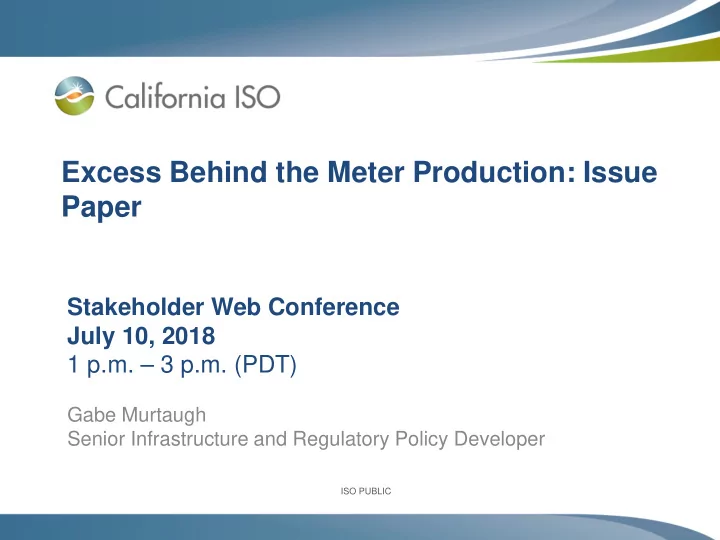

Excess Behind the Meter Production: Issue Paper Stakeholder Web Conference July 10, 2018 1 p.m. – 3 p.m. (PDT) Gabe Murtaugh Senior Infrastructure and Regulatory Policy Developer ISO PUBLIC ISO PUBLIC
Agenda • Introduce policy and timeline • Background • Goals for the initiative – Clarify tariff langue around BTM treatment – Identify a reporting standard for excess BTM production – Identify potential impacts to scheduling coordinators • Excess BTM production example • Outline potential treatment options • Questions and next steps ISO PUBLIC Page 2
INTRODUCTION AND STAKEHOLDER PROCESS Jimmy Bishara Senior Stakeholder Engagement & Policy Specialist ISO PUBLIC Page 3
Stakeholder Process POLICY DEVELOPMENT POLICY DEVELOPMENT Additional Additional Straw Straw Papers Papers Proposal Proposal Draft Draft Revised Revised Straw Board Issue Final Final Straw Issue Straw Proposal Paper Q1 2019 Proposal Proposal Proposal Paper Proposal Stakeholder Stakeholder Stakeholder Input Input Input We are here ISO PUBLIC Page 4
The ISO is targeting a proposal to the Board in the first quarter of 2019. Stage Date Milestone June 28 Post issue paper Issue Paper July 10 Stakeholder call on issue paper July 24 Written comments due for issue paper October, 2018 Post straw proposal Straw proposal October, 2018 Stakeholder call on straw proposal November, 2018 Written comments due for straw proposal January, 2019 Post draft final proposal Draft final January, 2019 Hold stakeholder meeting proposal February, 2019 Final comments due Final proposal Q1 2019 Present proposal to Board of Governors ISO PUBLIC Page 5
List of acronyms/abbreviations used in this presentation. BTM Behind the Meter TAC Transmission Access Charge UDC Utility Distribution Company UFE Unaccounted for Energy ISO PUBLIC Page 6
ISSUE PAPER FOR EXCESS BTM PRODUCTION Gabe Murtaugh Senior Infrastructure & Regulatory Policy Developer ISO PUBLIC Page 7
Background information on excess BTM production. • Excess behind the meter production is when behind the meter generation exceeds a consumer’s host load • Non-utility scale solar (behind the meter solar) production is rapidly growing in California • As growth continues, accounting for excess behind the meter production will become more important • Excess BTM production treatment can impact outcomes for TAC, UFE and other charge codes ISO PUBLIC Page 8
There are three primary goals for this initiative. 1. Create working, straightforward definition of Gross Load, where treatment of excess BTM production is expressly addressed 2. Develop a standard reporting practice and determine appropriate market mechanism to account for excess behind the meter production 3. Explore potential impacts to scheduling coordinators ISO PUBLIC Page 9
A simplified example for illustration with total production and total load at 6 MW. Reported Values (MWs) Household 1 Household 2 Load 1 MW 5 MW Rooftop Solar Output 2 MW 0 MW Meter Read 0 MW 5 MW (Load Channel) Meter Read 1 MW 0 MW (Export Channel) ISO PUBLIC Page 10
A simplified example for illustration with a household with a 1 MW load and 2 MW of solar production. Without Rooftop Solar With Rooftop Solar GEN GEN (6 MW) (4 MW) HH 1 HH 2 HH 1 HH 2 (1 MW) (5 MW) (1 MW) (5 MW) ISO PUBLIC Page 11
Within this example Gross Load could be calculated by either “netting” or not netting excess BTM production. • “Netting” excess BTM production results in a total Gross Load of 4 MW, or the sum of all load, less solar output • “Not Netting” excess BTM production results in a Gross Load of 5 MW, or the sum of the metered load channels • If values are reported either way, the ISO settlement process cannot determine excess BTM production • If this value is reported differently by two different UDCs it has implications for TAC, UFE and other settlement charges ISO PUBLIC Page 12
Goal 1: Updating the definition for Gross Load in the tariff. • The ISO proposes to clarify the tariff definition of Gross Load to state that excess BTM production should not be netted from Gross Load • Updating this definition and subsequent reporting practices will remove potential settlement differences that arise from differing reporting methods across UDCs and increased reliability support and better capacity services requirements ISO PUBLIC Page 13
Goal 2: Develop a reporting standard for excess BTM production. • The ISO would like to solicit stakeholder feedback on this goal particularly • Once the Gross Load definition is clarified there may be additional need to clarify language around how values for excess BTM production should be treated • Two potential market mechanisms to apply to excess BTM production: – Treatment as Supply (Pseudo Generation) – Treatment as Demand (Negative Load) ISO PUBLIC Page 14
Initial analysis of the two potential mechanisms PROS CONS 1. Treatment as • Would be possible to model • Data granularity beyond 5- generation at 5-minute level in the future minute market may not be available • Gross load values may be inflated because of accounting approach • Additional market changes may need to be implemented to account for this approach 2. Treatment as • Gross loads would be negative load accurately reported • Minimizes impacts to settlements • Generation could be modeled on an hourly basis ISO PUBLIC Page 15
QUESTIONS AND NEXT STEPS Jimmy Bishara Senior Stakeholder Engagement & Policy Specialist ISO PUBLIC Page 116 Page 11
Recommend
More recommend